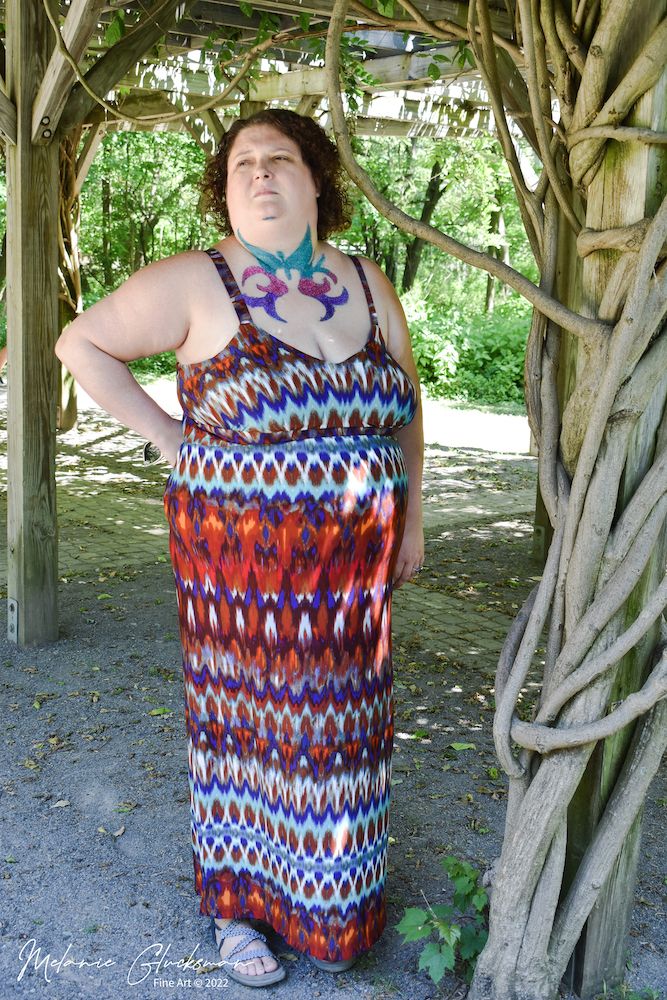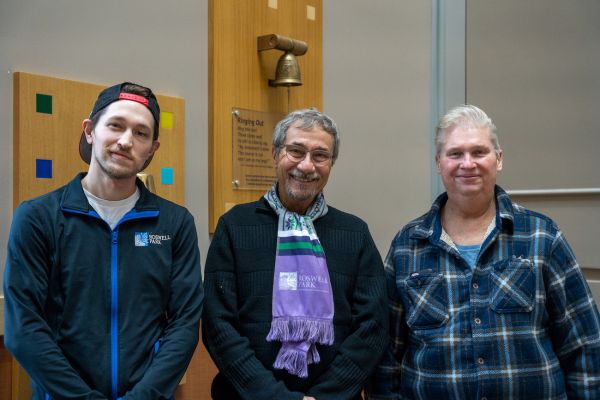Six years ago, Melanie Glucksman was a different person. The birth of her daughter, becoming a single mother and working multiple jobs to support herself and her new baby while learning how to be a parent all at the same time was a lot. She stepped away from her passion for art to focus on surviving.
Now she’s a medical records associate at Roswell Park Comprehensive Cancer Center. Her daughter is thriving and picking up mom’s creative streak and, together, they’re helping spread a little positivity and healing to other women who have been through difficult situations.
“I’ve wanted to do something like this for so long,” says Melanie, who has a side business in which she paints children’s faces. One night, she applied skin-grade glue and glitter to the stretch marks from her pregnancy and showed them off to her daughter. “I wanted to show her I was proud of my c-section scar from having her. She said, ‘Mommy, that’s beautiful,’ and it turned into a whole thing.”
Inspired, Melanie started a Facebook page, calling her effort the Glitter Scar Project, and sharing the information across the mothers’ groups she joined. She began offering free glitter painting on other women’s scars – physical or metaphorical – to help them embrace their beauty and power, as a way to help heal and embrace their lives.
“I started with some friends and in my local mommy groups. People started telling their friends,” she says. “I had about 200 women come forward but, so far, I’ve only photographed around 60.”
Each woman has the opportunity to meet with Melanie at a location of their choice to have glitter applied on their scar or the location of their choice. The process takes between 30 minutes and an hour, depending on the size and detail of the design, and the glue and glitter last on the skin for several days.
“I’ve always wanted to do something like this but I never had the right idea,” she says. “Getting back into art is amazing and helpful. I always wanted to help people.”
Transformation through art
The results are deeply personal and, for many women, cathartic.
In 2015, Lindsay Giardina was diagnosed with thyroid cancer. Fortunately, it had not metastasized and, after surgery to remove her thyroid, she was considered cancer-free. Unfortunately, that was the beginning of a long journey of recover, as her body rejected the first thyroid-replacement medication she was given. After that was under control, she became severely anemic.
Lindsay learned of the Glitter Scar Project through a Facebook group both she and Melanie belong to and decided to reach out.
“My scar is significant. It goes across my whole neck,” Lindsay says. “When it was first healing, for about a year, I was wearing scarves all the time. The scar was the only thing I saw when I looked in the mirror.”
When she met with Melanie, Lindsay showed her a design of a butterfly, the same shape of the thyroid and one associated with thyroid cancer survivorship. She asked for a butterfly to be made in glitter around her neck, in the same purple and teal colors associated with the cancer.
After the glitter was applied and the photo shoot, Lindsay and Melanie walked through a park in West Seneca together and spotted a fawn grazing nearby. To Lindsay, it was a spiritual moment, “a reminder of God’s hand in my healing journey.”
“To embrace that scar and that journey, that whole process as part of who I am now and putting a positive spin on it, was so important to me,” Lindsay says. She went to the Taste of Buffalo after having the glitter applied and received compliments from people at the festival for her eye-catching adornment.
“I’m so glad I did this,” she says. “At the time, I was very tired. It was before my anemia diagnosis. Now I don’t even see the scar. It has sort of faded into the background. It’s been a really long process but I’m getting there.”
Never miss another Cancer Talk blog!
Sign up to receive our weekly Cancer Talk e-newsletter.
Sign up!A powerful message
Janna Willoughby-Lohr was warned she might have trouble getting pregnant after having a cervical cold knife cone biopsy to remove tissue that her doctor feared was cancerous. She was told, at the time, that if she did get pregnant, she might have trouble carrying to full term.
Three children later, now ages 7, 5 and 1, she is proud of the mother she’s become and the stretchmarks she bears from those pregnancies.
“I’m a big proponent of celebrating women in the bodies we have,” Janna says. “So many of the images we see of women are either doctored up to make them look perfect or they find women who are really thin and have no scars. That’s why so many women end up feeling badly about their appearance, because that’s what they see all the time. They think, if I don’t look that way, there’s something wrong with me.”
Like Lindsay, Janna learned about Glitter Scar through a Facebook page and decided it was important to participate. “I wanted my sons to see me out in a public park with my stripey belly. I picked the colors, jewel tones of purple, pink, teal, gold and green, because they’re my favorites. It was weird and a little awkward and while I tend to come off as this superhero, everything is great, it did feel weird to be in a public park with people watching me, but I wanted my daughter to see that, even though she’s little, because some day she’ll see these pictures and I want her to see it’s OK to have a body that has imperfections. Not only is it OK, it’s normal. What’s not normal is people appearing perfect.”
Both Janna and Lindsay said seeing the glitter, a decoration associated with attracting light and attention and ubiquitous in moments of joy, helped them feel better in their own skin. It gave them reason to appreciate how far they’ve come.
“For me, having the glitter on at home was way cooler than looking at the pictures,” Janna says. “Every day, when I’d take a shower and get dressed, I’d look in the mirror at the stretchmarks and see how fun and sparkly they were.”
Finding a new application for her love of art has helped Melanie heal as well. “It reminds me that I’m not alone in the things that happened. I love doing this. It’s given me a new life, almost. I’m doing this because it feels important. Women are told we have to be quiet and keep our mouths shut. But not this generation of women. We’re strong, we’re independent. We’ve been through more things than people can ever know. We should be really proud of that.”



